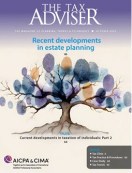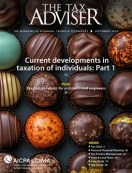- column
- TAX TRENDS
Tax Court holds firm to deadline for petition filed after midnight Eastern time
Related
AICPA asks Treasury, IRS to change approach to dual consolidated losses
About 1 million taxpayers to get automatic penalty relief next year
IRS clarifies how employees can claim 2025 tip and overtime deductions
The Tax Court held that a Tax Court petition filed electronically by the taxpayers at 11:05 p.m. Central time on the last day to file a petition was not timely filed.
Background
The IRS mailed Roy and Bonnie Nutt a notice of deficiency on April 14, 2022, determining an income tax deficiency and an accuracy-related penalty for 2019. Although mailed earlier, the notice was dated April 18, 2022, and it stated that the last day the Nutts could file a Tax Court petition in response to the notice was July 18, 2022. The IRS also sent a letter dated June 7, 2022, to the Nutts in which it reduced the amount of the deficiency and reminded the Nutts that the deadline for them to file a petition in the Tax Court was July 18, 2022.
The Nutts, who resided in Alabama, electronically filed a petition with the Tax Court at 11:05 p.m. Central time on July 18, 2022. At the time of filing, the court’s electronic case management system automatically applied a cover sheet to their petition, which showed that the Tax Court electronically received the petition at 12:05 a.m. Eastern time on July 19, 2022, and filed it the same day.
The IRS filed a motion to dismiss the Nutts’ case on Sept. 1, 2022, contending that the Tax Court lacked jurisdiction over the case because the petition was not filed within the time prescribed by Sec. 6213(a). The Tax Court ordered the Nutts to file an objection to the motion if they had one, but they did not respond.
The Tax Court’s decision
The Tax Court held that a document that a taxpayer files electronically with the court is filed when it is received by the court as determined in reference to where the court is located. Because the Nutts electronically filed their Tax Court petition after the due date in the Eastern time zone, where the Tax Court is located, the court further held that the petition was untimely and granted the IRS’s motion to dismiss the case for lack of jurisdiction.
Under Sec. 6213(a), a taxpayer who has received a notice of deficiency who wishes to have the Tax Court review the IRS’s deficiency determination must file a petition with the court within 90 days after the notice of deficiency is mailed. Under Sec. 6213(a), if the notice of deficiency specifies a last day for filing a petition that is later than the 90th day, then the deadline to file a petition is extended to the date specified. Sec. 7503 provides that if the last day falls on a Saturday, Sunday, or legal holiday in the District of Columbia, the deadline is extended to the next day that is not a Saturday, Sunday, or legal holiday. Under these rules, the Tax Court found that the last day for the Nutts to file a petition with the Tax Court was Monday, July 18, 2022, the last date for filing stated in the notice of deficiency.
Although the Tax Court may sit at any place within the United States, a petition is generally considered filed when it is received by the court at its principal office in Washington, D.C. If a petition is delivered to the court by U.S. mail or a designated delivery service, the Sec. 7502(a) timely mailing rule applies. Under this rule, a document that is mailed before it is due but received after it is due is deemed to have been received when mailed.
As it is not delivered by U.S. mail or a designated delivery service, an electronically filed petition is not covered by the timely mailing rule. Under its own precedent, the Tax Court found that where Sec. 7502 does not apply, it is obliged to look to the date a taxpayer’s petition was actually received and filed by the court to determine whether it was timely filed.
Consistent with the statutory framework, Tax Court Rule 22(a) provides that a document must be filed with the Tax Court clerk in Washington, D.C., during business hours unless it is electronically filed. If it is electronically filed, Rule 22(d) states that a document “will be considered timely filed if it is electronically filed at or before 11:59 p.m., eastern time, on the last day of the applicable period for filing.”
Besides being consistent with the statutory framework, the Tax Court also found that Rule 22 was consistent with other federal rules and case law. The court noted that Rule 6(a)(4) of the Federal Rules of Civil Procedure provides that the last day of a period for electronic filing ends “at midnight in the court’s time zone” (emphasis added by the Tax Court). Also, in interpreting Federal Rule 6(a), the Seventh Circuit has observed that electronic filing systems have the effect of extending the number of hours available for filing, from when the clerk’s office closes until 11:59 p.m. in the court’s time zone, but not the number of days. In addition, the Tax Court found that, as with Federal Rule 6(a), Rule 22(d) is in accord with the idea that the court’s electronic filing system serves as a substitute for the clerk of the court.
Under Tax Court Rule 25(b)(2)(C), the period within which to file a petition cannot be extended by the court. Taking into account this rule and Rule 22(a), the court concluded that if it held that the Nutts’ electronically filed petition was timely because it was still the last day to file in Alabama, even though the last day had ended in the District of Columbia, it would impermissibly be extending the number of days available for filing. Accordingly, it was required under Sec. 6213(a) to dismiss the Nutts’ case for lack of jurisdiction.
Reflections
One might feel sorry for the Nutts here if the Tax Court were enforcing an obscure or hard-to-find rule. However, as the court points out in its opinion, the Tax Court provides instructions on its website on how to file a petition electronically (in a place where anyone seeking to file an electronic petition would be likely to find them), and the first subsection of the instructions, titled “Check the Deadline for Filing,” states, in bold, “The Court must receive your electronically filed Petition no later than 11:59 pm Eastern Time on the last date to file.” Thus, it seems fair to say that the Tax Court has made an adequate effort to make taxpayers aware of the Eastern time zone rule for filing a petition electronically.
Nutt, 160 T.C. No. 10 (2023)
Contributor
James A. Beavers, CPA, CGMA, J.D., LL.M., is The Tax Adviser’s tax technical content manager. For more information about this column, contact thetaxadviser@aicpa.org.














